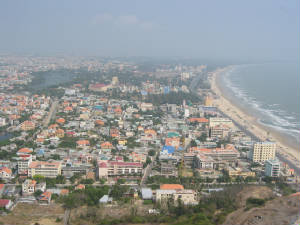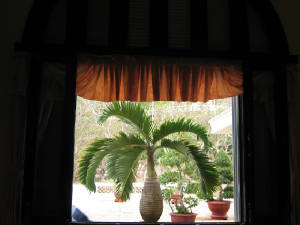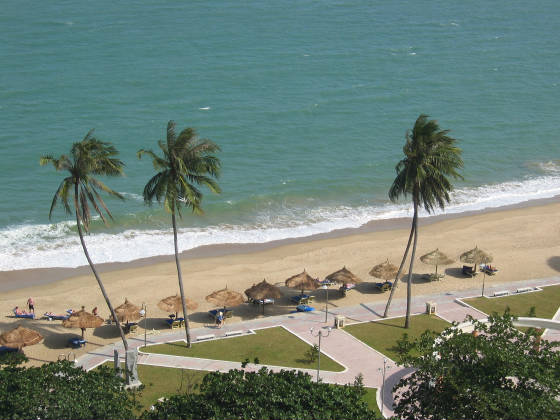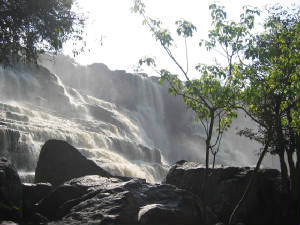|
|
 |
|
Vung Tau

Vung Tau’s beaches are the best for
collecting seashells, observing the million tiny crabs (which aren’t “true” crabs) that dig up holes in
the sand, and searching for starfish. Vietnamese people will tell you that Vung
Tau’s beaches are filthy. Though they certainly are not as clean as other
beaches in Vietnam,
they are still infinitely cleaner than American beaches, particularly those in New York,
which are filled with cigarette buds and food litter. In Vung Tau, you should
swim and jog early in the morning when the tide is low. The beach will look especially
pristine. The sand is so flat and clean at this time, that you won’t even
want to touch it. In the afternoon, however, you will have to maneuver around
bags of instant noodles every so often.

People will tell you that Cay Bang is the most famous seafood restaurant
in Vung Tau, known for its inexpensive and delicious dishes. But this is not
true. Don’t believe it. First
of all, the restaurant is dirty by western standards. Be prepared to sit on old
plastic chairs and wave flies away from your food as you eat. Though the seafood
is decent, it is nothing spectacular. What’s worse is the check, which
will be even more expensive than a comparable meal at a 4 star hotel. As foreigners
you have to beware of places whose menus do not have set prices like Cay Bang. Furthermore,
if you wish to stay at one of the nicest hotels in Vung Tao, Dic Star, you’ll have to pay a hefty taxi cab fee to venture
to this mediocre and disappointing restaurant.

|
| A window from Bao Dai's summer home |
The most frequented tourist destinations in Vung Tau include the Jesus statue
located on the highest hilltop in the city, a French mansion that once served as King Bao Dai’s summer house, and the
Thich Ca Phat Dai Pagoda. They are all worth a quick look.
|
 |
|
Mui ne
Seafood in Vietnamese beach towns
can’t be beat. The prices are low and the selection is fresh. I was very careful about everything I stuck in my mouth in Vietnam, so it was with much surprise when a plate of squid
sautéed with lemongrass, served at my beautiful resort in Mui ne, put me to bed for an entire day—except when I was
in the bathroom, throwing up.
Mui ne doesn’t have too many attractions to offer tourists,
so a couple of days at one of its magnificent resorts should be sufficient. The
beach is absolutely untouched in this city. You will also enjoy yourself walking
up its red sand dunes (yes, with red sand) a little ways up from the Pandamanus Resort. You will feel like you’re in
the Sahara Desert with a mirage of the ocean on your other side. Go on the weekends
and take advantage of chatting with the young children who like to play tour guide as you climb up the hills. These kids will provide you with fun conversation and blue plastic sleds to slide down the dunes with. If you look especially friendly, they will accompany you on your way up, offering
to hold your sandals and massage your back! Remember to give them a little tip,
though, if you’d like to. A lot of these children go to school on regular
days and only hang out on the dunes on weekends to make a little extra cash for their families.
|
 |
|
|
|
 |
|
|
|
Nha Trang
Nha Trang is one of the most
popular cities among Vietnamese and foreign travelers. Its beaches are ultra
clean. It’s also more swim-able than Vung Tau’s beaches because of
its calmer waters. After the first strong wave that laps against the shore, the
ocean is virtually still. There’s lots to do in the city—shop, eat at a variety of restaurants, go to discoteques,
or walk along the 7 km beach at night.
There’s also lots to do around Nha Trang. You can take a boat to
several islands and swim in even cleaner beaches. I went parasailing in Hon Tam
for 250,000 dongs. You can visit an aquarium that’s built in the shape
of a boat and look at beautiful corals (if they haven’t died yet because of aversive weather).
One of the most enjoyable destinations in Nha Trang is an island filled with monkeys—nearly 1000 of them. They wander around and you can wander around amongst them. Make sure to bring bananas along, or buy bags of nut and corn mix to feed them. It is amusing to watch the monkeys fussily prefer the nuts over the corn.
If I ever return to monkey island, though, I’ll remember to wear long pants, as one of the monkeys scratched
my ankles. I also got a fright when a monkey leaped onto my chest and snatched
an entire bag of nut mix out of my hands. The monkeys are fascinating to observe
in a Kafkian way. It isn’t uncommon to be surrounded by 20-30 of them,
waiting to be fed. The cirque on the island is also fabulous entertainment for
kids and adults.
Finally, you can finish up your visit to Nha Trang with an afternoon at Thap Ba Hot Spring
Center, soaking in a mud bath and swimming
in the mineral water pool.

Da Lat

Da lat is quite pretty—the
Frenchy part of it, at least. The Vietnamese part is full of shabby houses. It’s messy and chaotic there. Motorbikes
and cars drive faster in Da lat, so one should beware. However, for the most
part, the city is one of the prettier ones in Vietnam. There
are French villas on hills, a golf course filled with evergreen-like trees, a lively market similar to, but dirtier than,
Che Saigon (or Ben Thanh, as it is now known). And a huge lake, Xuan Huong, is
in the center of the city. It has a 7 km circumference. As Da lat has traditionally been a city for honeymooners, should you be inclined, you can paddle around
the lake on swan-shaped boats.
Café de la Poste and the breakfast buffet at the Novotel and Sofitel Palace
provided the most delectable French cuisine I enjoyed in Vietnam.
(It is astonishing how, with French rule for 100 years, the Vietnamese have not learned how to cook better French dishes!) Da lat grows a variety of fresh legumes, so the lettuce selection is diverse. The leaves are larger, fresher, and crunchier than any you’ll find in bagged
organic produce in the states. Also, don’t miss out on the selection of
fruity candies in Da lat and their famous Artichoke (called there: artiso) teas.
|
|
|
 |

